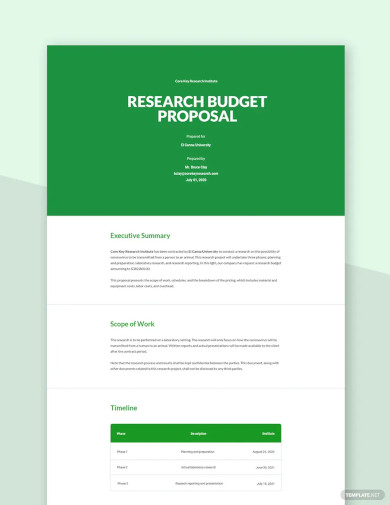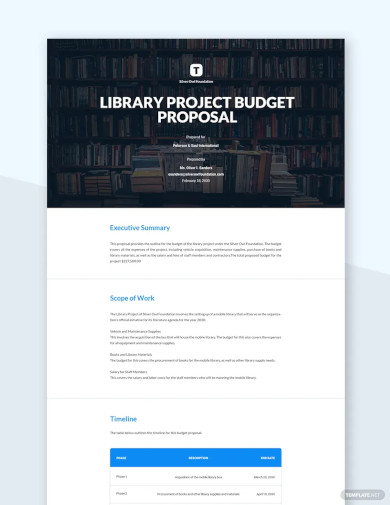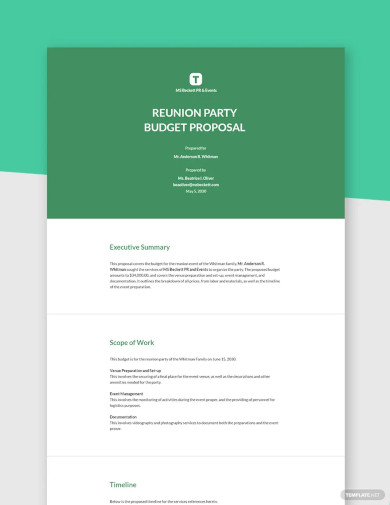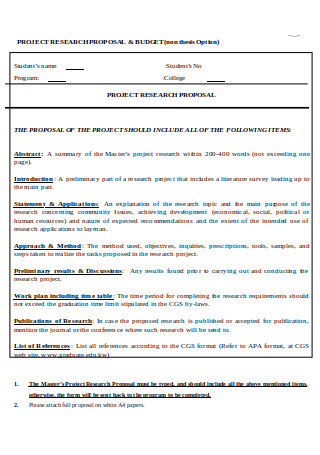42+ Sample Budget Proposal Templates
-

Simple Budget Proposal Template
download now -

Business Budget Proposal Template
download now -

Restaurant Budget Proposal Template
download now -

Project Budget Proposal Template
download now -

Kitchen Remodelling Budget Proposal Template
download now -

Budget Proposal Request Letter Template
download now -

Research Budget Proposal Template
download now -

Team Building Budget Proposal Template
download now -

Conference Budget Proposal Template
download now -

School Budget Proposal Template
download now -

Investor Budget Proposal Template
download now -

Budget Proposal Presentation Template
download now -

Software Budget Proposal Template
download now -

University Budget Proposal Template
download now -

Grant Budget Proposal Template
download now -

Team Building Budget Proposal Template
download now -

Event Budget Proposal Template
download now -

Sample Budget Proposal Template
download now -

Standard Budget Proposal Template
download now -

General Event Budget Proposal Template
download now -

Editable Grant Budget Proposal Template
download now -

Sample Budget Notes
download now -

Notes to Event Budget Proposal
download now -

Research Business Proposal and Budget
download now -

School Summary Proposal Budget
download now -

Expense Report and Budget Seminar Proposal
download now -

Design Budget Proposal Template
download now -

Budget Plan Proposal
download now -

Sample Travel Budget Narrative
download now -

Budget Change Proposal Cover Page
download now -

Project Budget Proposal
download now -

Small Business Proposal Budget Toolkit
download now -

State Budget Thesis Proposal
download now -

Proposal Budgeting Program Basics
download now -

Sample Request Grant Proposal Budget
download now -

NGOs Project Proposal
download now -

Standard Non Profit Budget Proposal
download now -

Eligible Costs & Training Proposal Budget
download now -

Budget for Research Grant Proposal
-

Budget Proposal Project
-

Research Budget Format
-

Budget proposal Strategies
-

Budget Proposal Form Template
download now
In this article, we will discuss what is a budget proposal, how to write a good budget proposal, and the dos and don’ts when making one. We will also provide you with business proposal templates you can use as a guide or reference.
To help you come up with a budget proposal, you can use these more than 20 budget proposal samples as a guide or reference.
What Is a Budget Proposal?
According to Dartmouth, “a budget proposal serves as a blueprint for spending the project’s funds, and outlines the project in fiscal terms and helps reviewers to determine how the project will be conducted.”
A budget proposal gives an overall picture of the finances required for a project to operate and contains the budget for projected finances and expenses of a project. The primary purpose of a budget proposal is to brief your stakeholders about the project, present them a project cost breakdown, project timeline, as well as the desired outcomes. Budget proposals are mainly used to request for a grant or funding from investors, stakeholders, government, and institutions. It will present the justifications for the cost estimates required for the successful operation of the project.
Why Do You Need to Carefully Plan Your Budget Proposal?
When you’re seeking funding or grant, having a detailed, comprehensive budget proposal will increase your chances of being approved for funding or grant. Good budget proposals show investors or funding institutions how you can effectively handle the funding to accomplish the project goals.
By having a carefully laid-out budget proposal, it would be easier for you to manage your daily costs and expenses when the project commences. It will also help you avoid overspending more than your budget allows. Since budget proposals contain the projected spending on a weekly, monthly, quarterly, or yearly basis, you can easily allocate or reallocate your funds to specific items or activities. You can also easily review each budget item and spending during and after the actual project.
Budget proposals can also help you grasp your project better. Having an overall financial picture of your project will also help you manage your project so that you can achieve your project goals and outcomes.
After the project has been done, the budget proposal can also be used as a comparison tool for the projected expenses versus the actual spending for the entire project. It will also help assess how much was the money allocated and spent on each item, which item had the highest and lowest budget, and were the funds efficiently used or spent.
The budget proposal will also serve as one of the references when you’re making a project report during or after the end of the project. Your budget expenditures will show how efficiently and effectively you’ve used the funds, and where you spent the funds.
Elements of a Budget Proposal
In this section, we will discuss the common elements of a budget proposal, so you can refer to this from time to time.
Step 1: Make a cover page and letter for the budget proposal
It is important to have a clean, professional, and great-looking cover page. It is the first thing a person examining your document sees, so you better put your best foot forward. Next is the cover letter which presents the project and its proposed budget to the funding institution, stakeholders, partners, shareholders, and investors.
Step 2: State the purpose and justification of the proposed budget
Here you will state the purpose of the budget in achieving the project’s goals, objectives, and desired outcome. You will also justify the proposed budget, explaining the costs per item. You will also be explaining how you were able to come up with the proposed budget, and how the said budget will help you achieve your goals. It is also good to explain how the benefits exceed the cost of the project. You can go ahead and check out this budget proposal template for inspiration.
Step 3: Breakdown of the Costs per Item
Here, you will outline the budget for direct costs or overhead expenses, administration and facilities, materials, equipment costs, labor, and other expenses for the project. It is better to present the breakdown in a table format, with columns for the cost item, costs, total, and the justification per item. You may also separate the direct expenses from the indirect expenses. Direct costs or expenses are the following items: materials and equipment, labor, activities, food and the like. Indirect expenses are the following costs: travel expenses, utility, salaries and professional fees for staff and consultations, incentives, and miscellaneous expenses. You may also choose to have a separate section for these expenses, such as: Direct Labor, Equipment and Materials, Travel and Miscellaneous Expenses.
For the Direct Labor, you can specify how many employees or contractors do you need, what are their positions, their hourly or daily rate, the total fees or salary for each employee or contractor, and the total budget required. You may also include an explanation of why you need to hire these employees or contractor, and what duties and responsibility will each of them perform.
While for Equipment and Materials, you can identify or enumerate the equipment or materials required for the project, the unit price for each, the total cost per item, and the total budget required. You may state why you need this equipment and materials, and how it will help you achieve your project goals.
On the other hand, for travel and miscellaneous expenses, specify each of these expenses and its description, the total estimated cost for each of these expenses, and the total budget required.
You will also specify the bare minimum cost for each expense, as well as the total budget for each item for the entire project duration. In the other column, you can put the justification for the budget, explaining why you are requesting this budget for the said item.
You can also include a justification or rationale behind these costs, and their corresponding amount. Explain why you need the said item, and why you are requesting this amount of money.
It is also good practice to put the cost breakdown in a Google Spreadsheet or Microsoft Excel file, for easier tracking, calculation, and review. Remember that the Excel file is a working document that you need to check, review, and update from time to time.
Step 4: Cost Summary or Financial Summary
The cost summary presents the total cost or budget for the entire project. In a nutshell, the cost summary will show the total estimated cost for the major expenses, such as: Direct Labor, Equipment and Materials, and Travel and Miscellaneous Expenses.
Step 5: Delivery or Timeline
Here, you will show the timeline specifying the spending to be incurred by the project on a daily, weekly, monthly, quarterly, or yearly basis, depending on the project.
Advice and Tips on How to Prepare A Budget Proposal
1. Familiarize yourself with the project.
Before you start contemplating the costs and operations for the project, It is best you know very well the nature of the project. You can communicate directly with a project director and discuss all the possible operations and costs of the project.
2. Utilize Historical Data
If there are similar or recurring projects in your business, reviewing previous proposals can help you evaluate these data and use as a reference for your budget proposal. These data can be used as you will be able to analyze effectively what works and does not for the company. Past budget proposals can be very convenient as you do not have to create one from scratch.
3. Learn from past lessons
An ill-prepared budget proposal can restrain a project from overspending. That’s why it is important that you review previous financial data before making one. If there is a need to make a budget proposal from scratch, you may need extra research on that specific project from established companies and experts. But when you’re new to budget proposal-making, it is necessary to follow and modify a budget proposal template, to make the process easier and manageable.
4. Consult with Experts
There is nothing wrong with asking for expert advice from your team, and even stakeholders. It is better to reach out for help so they can provide substantial input to your proposal than submitting it right away and end up having a major revision of your budget pitch or worse get rejected.
5. Review Your Proposal
It is best that you review your proposal to verify the accuracy of your data and keep the project from minimum errors. Operation costs, especially overhead expenses factor in the budget to keep your project afloat.
6. Analyze financial Records
Double-check the variable costs and fixed costs, and how it will change over the years. Forecasting annual costs will be beneficial for your budget proposal since it can help you make calculated assumptions of the inflation rate on every operation costs of your project.
7. Lay-out the day-to-day activities in full perspective
Once you have mapped out in full detail the duration of each task, it is easy for you to define the total cost of each item to run the project (such as hourly rate, and other additional costs). You should also include the type of team or persons directly and indirectly involved in the daily task. In this way, it will be efficient to monitor who to consult on the progress of each task.
8. Estimate Costs
Put in your best effort to estimate costs correctly. You can do this by reviewing your Gantt charts and verify if all resources are associated with each task accurately. You can start with the hourly rate of the resources needed like electricity, equipment rentals, the hourly rate of staff, and so on. Then you can proceed with enumerating the possible materials needed for the project and other types of costs on your list.
9. Declare Subcontracting and Travel Costs
If there is a need to outsource some of the tasks or to incur travel expenses, it should be in your budget proposal. Make sure you have ample documents to support why the need for the acquisition of a subcontractor or to cover the travel costs or even daily allowance.
10. Set Clear Timetable and deliverables
Since you are still proposing to your sponsor, the key to winning your budget proposal is always the presentation. Make it simple but accurate and concise. A properly structured timetable and its deliverables will keep your stakeholders informed of all the possible activities and help verify the target end date of the project.
11. Present yourself as a reliable and credible person with sufficient background to carry out the project.
Capacity’ is also another important component of a project proposal. Donor agencies are interested to know how the organization proposing to implement a project is positioned with its skills and capacity. For example, if your organization has proposed to implement a project on ‘human rights empowerment’, the donor agency is going to assess if it has some previous experience in human rights, and at what level. Similarly, any women-empowerment projects require proposing NGO to justify that it has got the right skills to execute such a project. Capacity also includes the number of experts you have in your organization on the subject. In some proposals, they also request information about your staff so that the donors are convinced that the project execution is in the right hands.
Dos and Don’ts When Making Budget Proposals
Here are some of the things you should do when you’re making budget proposals. This list will help guide you when you’re making a budget proposal.
1. Do be transparent about why you need a certain budget.
You want to be transparent to your investors why you need that specific amount of budget to support your project. For every donor, it is important that there is ‘transparency’ in the process of developing and implementing a project. Transparency is about involving stakeholders, sharing ideas and building the project with every real activity connected to your goal and objectives.
2. Do make the cost reasonable and deliver value.
‘Impact’ is necessary because of which most proposals seek an enormous amount of information about the expected results. In fact, big donor agencies dedicate several pages of their proposal format documents on ‘results analysis’ to identify and understand that every penny spent will generate some impact at the ground-level. Further, the monitoring and evaluation process defined inside a proposal determines the ability of the agency to assess the impact the project will create in the long-run.
3. Do align your budget with the entire project goals and desired outcomes.
Your budget is like the gasoline for the engines of your car or the project to start, run, and get to its desired destination. That’s why it is important that your budget is aligned with the completion and achievement of your project goals and objectives. Without a proper and sufficient budget, you will not be able to complete the project, which leads us to the next step.
4. Do consider the costs carefully.
You should put careful consideration when estimating the costs per item or expenditure. You don’t want to underestimate which leads you to run out of funds and hampers the project operations. You also don’t want to overestimate, since it will decrease your chances of approval from funding institutions.
5. Do get a budget proposal template as a guide or reference.
Especially when you’re first starting out, you need to have a budget proposal template you can use as a guide or reference. Having a template will ensure that you are not leaving out any essential details, and you got the important information of the proposal covered.
On the other hand, here are some of the things you shouldn’t do when you’re making project proposals.
1. Don’t forget to check your numbers.
Always check your figures. Double-check if the budget you’ve allocated per item is correct, and can sustain the actual costs for the duration of the project.
2. Don’t overestimate and underestimate.
For the cost estimates, you don’t want to either overestimate and underestimate. You don’t want to overestimate which leads to bloated figures. Bloated figures might lessen your credibility, and also lead to funder’s distrust, so be careful when estimating the budget needed for your project. You don’t want to underestimate since you might run out of budget too soon, which will hamper your ability to keep the project running.
3. Don’t rely on your guesses.
Don’t guess your cost estimates. Better to be safe, and check the current market prices for your project’s materials and equipment.
